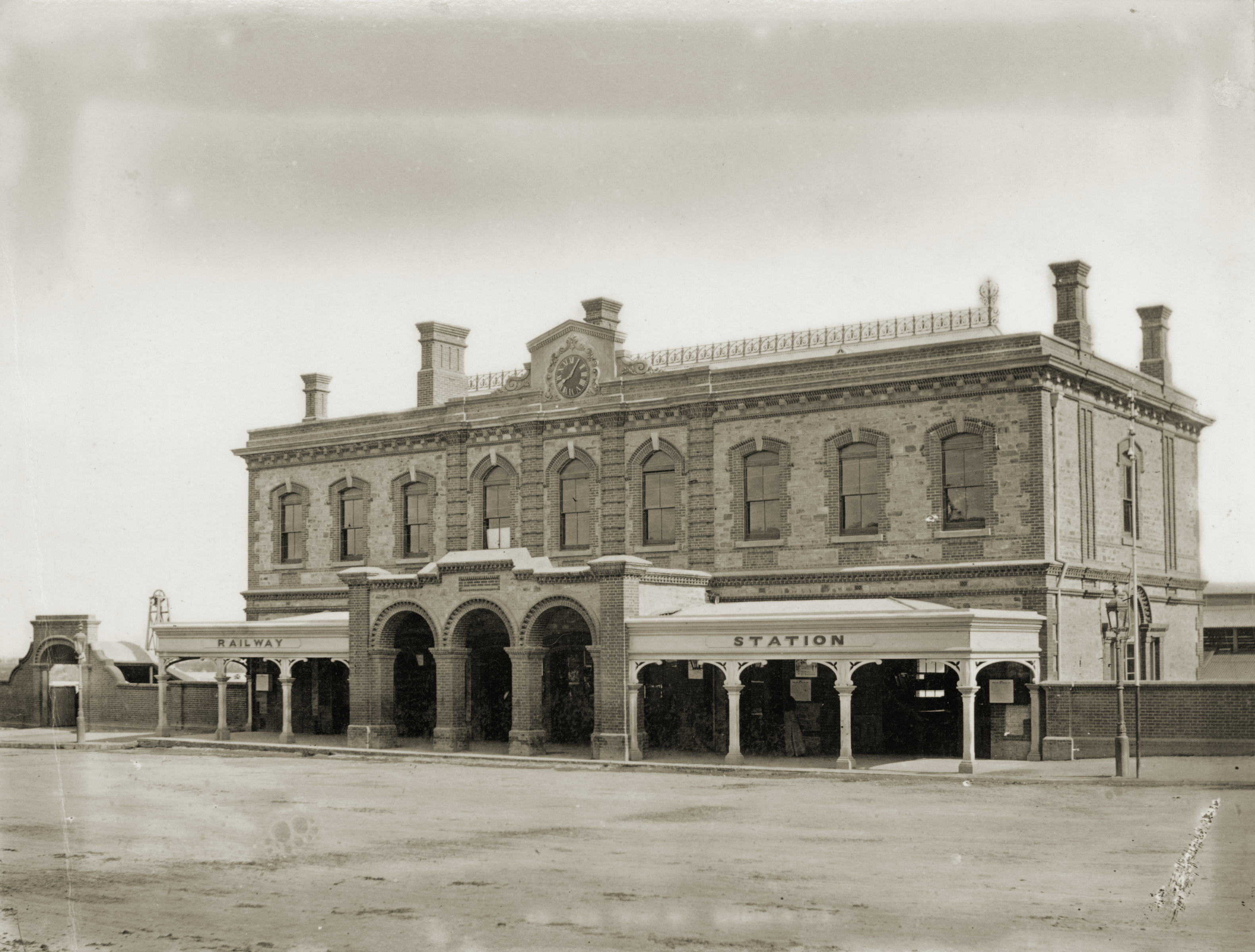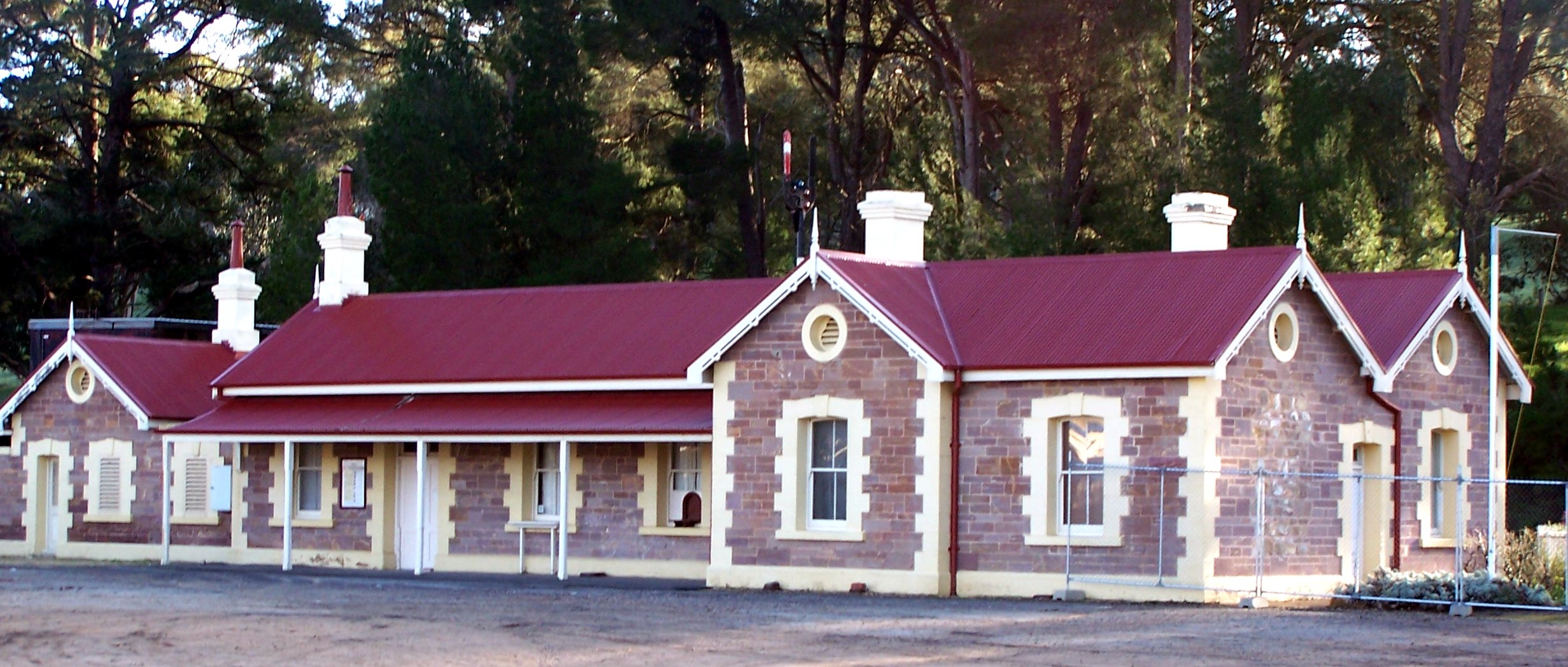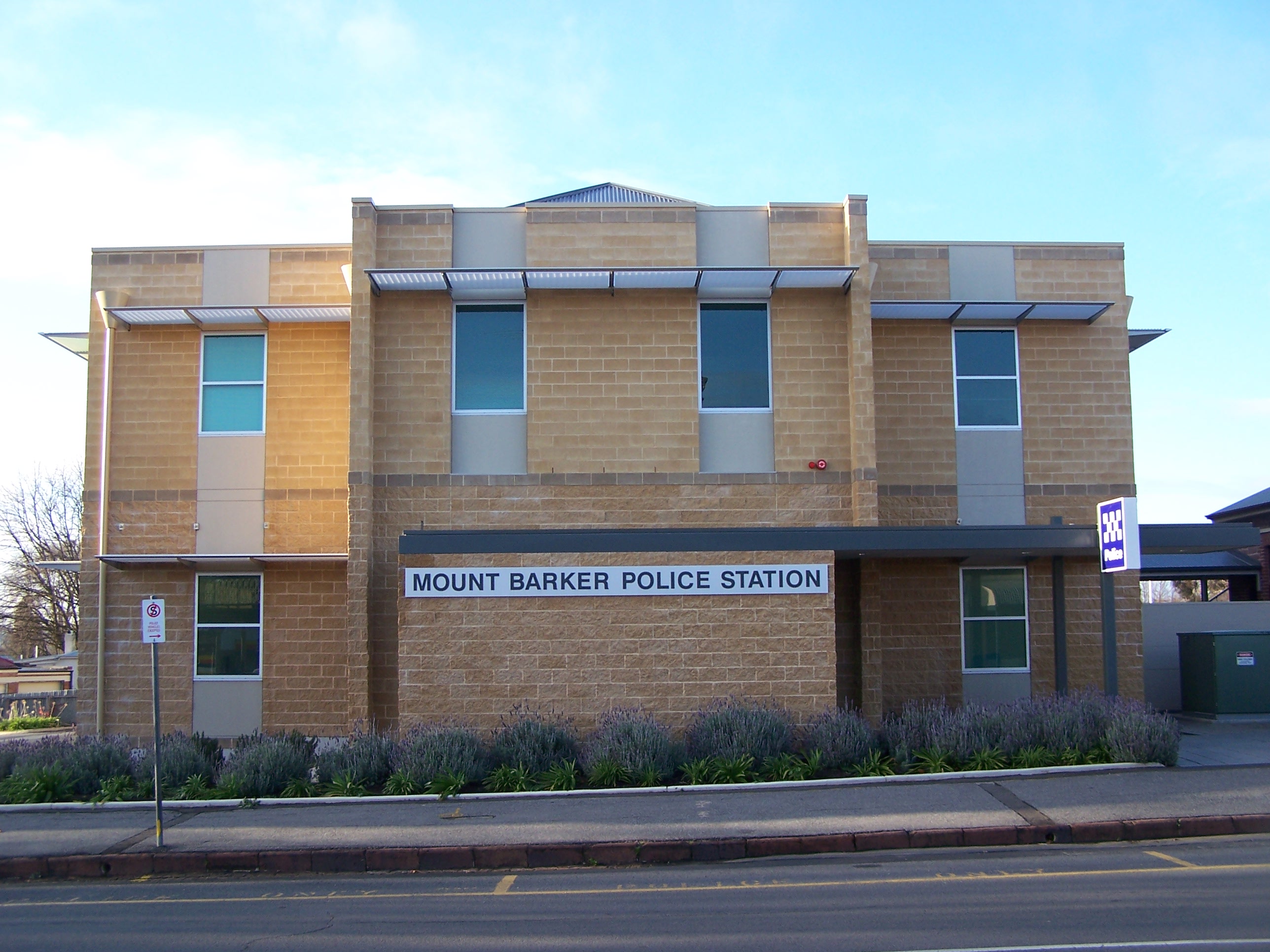|
Mount Barker Junction Railway Station
Mount Barker Junction railway station is a disused station on the Adelaide to Wolseley line serving the South Australian city of Mount Barker. History Mount Barker Junction station opened in 1883, and consisted of a main platform with a timber station building identical to the one at Balhannah, with a tall signal box next to the building. An island platform was built as well. The timber building and signal box were replaced with the current brick building in 1943. The island platform was demolished around the time the station closed to passengers by 1984 when the passenger service to Victor Harbor ceased. It became a junction station when the Victor Harbor line opened. When the Adelaide-Wolseley line was gauge converted to standard gauge in 1995, the Victor Harbor line was isolated from the rest of the Australian National network. SteamRanger The SteamRanger Heritage Railway is a long broad gauge tourist railway, formerly the Victor Harbor railway line of the Sou ... [...More Info...] [...Related Items...] OR: [Wikipedia] [Google] [Baidu] |
Adelaide Railway Station
Adelaide Railway Station is the central terminus of the Adelaide Metro railway system. All lines approach the station from the west, and it is a terminal station with no through lines, with most of the traffic on the metropolitan network either departing or terminating here. It has nine platforms, all using broad gauge track. It is located on the north side of North Terrace, west of Parliament House. The Adelaide Casino occupies part of the building that is no longer required for railway use. Until 1984, Adelaide station was also the terminus for regional and interstate passenger trains, but there are no longer any regular regional train services in South Australia, and all interstate services are now handled at Adelaide Parklands Terminal. History Early growth Adelaide's first railway station opened on the current North Terrace site in 1856. It served the broad gauge line between Adelaide and Port Adelaide, which was the first government-owned and operated steam railwa ... [...More Info...] [...Related Items...] OR: [Wikipedia] [Google] [Baidu] |
Victor Harbor Railway Line
The Victor Harbor railway line is a broad gauge line in South Australia. It originally branched from the Adelaide to Melbourne line at Mount Barker Junction then ran south to Victor Harbor. When the mainline was converted to standard gauge and the junction was closed, the northern end of the Victor Harbor line was curtailed at Mount Barker, from the junction. History South Australia's first railway venture was the line completed in 1854 from Goolwa, on the River Murray, to the small ocean harbour at Port Elliot. Short trains pulled by horses moved freight and passengers between the shallow-draft River Murray Paddle steamers and coastal and ocean-going vessels, bypassing the narrow, shallow mouth of the river with its unpredictable currents. However, Port Elliot was extremely hazardous; seven vessels had sunk there by 1864. The line was then extended to a safer harbour at Victor Harbor. The Institution of Engineers Australia placed a Historic Engineering Marker on the ... [...More Info...] [...Related Items...] OR: [Wikipedia] [Google] [Baidu] |
South Australian Railways
South Australian Railways (SAR) was the statutory corporation through which the Government of South Australia built and operated railways in South Australia from 1854 until March 1978, when its non-urban railways were incorporated into Australian National, and its Adelaide urban lines were transferred to the State Transport Authority. The SAR had three major rail gauges: 1600 mm (5 ft 3 in); 1435 mm (4 ft in); and 1067 mm (3 ft 6 in). History Colonial period The first railway in South Australia was laid in 1854 between Goolwa and Port Elliot to allow for goods to be transferred between paddle steamers on the Murray River and seagoing vessels. The next railway was laid from the harbour at Port Adelaide, to the capital, Adelaide, and was laid with Irish gauge track. This line was opened in 1856. Later on, branch lines in the state's north in the mining towns of Kapunda and Burra were linked through to the Adelaide metrop ... [...More Info...] [...Related Items...] OR: [Wikipedia] [Google] [Baidu] |
SteamRanger
The SteamRanger Heritage Railway is a long broad gauge tourist railway, formerly the Victor Harbor railway line of the South Australian Railways (SAR). It is operated by the not-for-profit South Australian Division of the Australian Railway Historical Society. As the last operating non-suburban line of the former broad-gauge network, on which Australia's first public railway was opened, the line and its associated rail assets have high historical significance. History In the 1970s, the South Australian Division of the Australian Railway Historical Society established SteamRanger as a not-for-profit railway preservation offshoot to operate its train tours from Adelaide, mainly on rural lines throughout the state's broad gauge networks. SteamRanger opened their first purpose-built depot at Dry Creek railway station, north of Adelaide in 1980. From the mid-1980's, SteamRanger gradually took over the operation & maintenance of the Victor Harbor railway line. When plans were an ... [...More Info...] [...Related Items...] OR: [Wikipedia] [Google] [Baidu] |
South Australia
South Australia (commonly abbreviated as SA) is a state in the southern central part of Australia. It covers some of the most arid parts of the country. With a total land area of , it is the fourth-largest of Australia's states and territories by area, and second smallest state by population. It has a total of 1.8 million people. Its population is the second most highly centralised in Australia, after Western Australia, with more than 77 percent of South Australians living in the capital Adelaide, or its environs. Other population centres in the state are relatively small; Mount Gambier, the second-largest centre, has a population of 33,233. South Australia shares borders with all of the other mainland states, as well as the Northern Territory; it is bordered to the west by Western Australia, to the north by the Northern Territory, to the north-east by Queensland, to the east by New South Wales, to the south-east by Victoria, and to the south by the Great Australian Bight.M ... [...More Info...] [...Related Items...] OR: [Wikipedia] [Google] [Baidu] |
Mount Barker, South Australia
Mount Barker is a city in South Australia. Located approximately 33 kilometres (21 miles) from the Adelaide city centre, it is home to 16,629 residents. It is the seat of the District Council of Mount Barker, the largest town in the Adelaide Hills, as well as one of the fastest-growing areas in the state. Mount Barker lies at the base of a local eponymous peak called the Mount Barker summit. It is 50 kilometres from the Murray River. Mount Barker was traditionally a farming area; many of the lots just outside the town area are farming lots, although some of them have been replaced with new subdivisions in recent times. History Mount Barker, the mountain, was sighted by Captain Charles Sturt in 1830, although he thought he was looking at the previously discovered Mount Lofty. This sighting of Mount Barker was the first by a European. Captain Collet Barker corrected Sturt's error when he surveyed the area in 1831. Sturt named the mountain in honour of Captain Barker after he was ... [...More Info...] [...Related Items...] OR: [Wikipedia] [Google] [Baidu] |
Balhannah Railway Station between 1918 and 1964.
The island platform had a shelter shed, this smaller platform has been removed but is unclear when, probably around 1995. The goods platform and goods shed still r ...
Balhannah railway station is a disused railway station on the Adelaide-Wolseley line. The station is in the Adelaide Hills town of Balhannah, and is located 45.8 kilometres from Adelaide station at an elevation of 339 metres.SAR Timetable 1954 p97 History The station opened in April 1883, originally with three platforms, the main platform of which had a weatherboard signal cabin, ticket office and the resident engineers office, like the one at Ambleside. It served as the junction station for the Mount Pleasant railway line The Mount Pleasant railway line is an abandoned South Australian line. It was opened between Balhannah and Mount Pleasant in September 1918 and ran until March 1963 as a freight and passenger service. [...More Info...] [...Related Items...] OR: [Wikipedia] [Google] [Baidu] |
Victor Harbor, South Australia
Victor Harbor is a town in the Australian state of South Australia located within the City of Victor Harbor on the south coast of the Fleurieu Peninsula, about south of the state capital of Adelaide city centre, Adelaide. The town is the largest population centre on the peninsula, with an economy based upon agriculture, fisheries and various industries. It is also a highly popular tourist destination, with the area's population greatly expanded during the summer holidays, usually by Adelaide locals looking to escape the summer heat. It is a popular destination with South Australian high school graduates for their end of year celebrations, known colloquially as Schoolies week, schoolies. History Victor Harbor lies in the traditional lands of the Ramindjeri clan of the Ngarrindjeri people. Matthew Flinders in visited the bay on 8 April 1802 while on the first circumnavigation of the continent, mapping the unsurveyed southern Australian coast from the west. He encountered N ... [...More Info...] [...Related Items...] OR: [Wikipedia] [Google] [Baidu] |
Junction Station
''Junction station'' usually refers to a railway station situated on or close to a junction where lines to several destinations diverge. The usual minimum is three incoming lines. At a station with platforms running from left to right, the minimum to qualify as a junction station would usually be one line on the left and two on the right (or vice versa). This is not to be confused with a station where there is one through line, but single track on one side while double track on the other. In this case, all trains passing through the station can reach only one destination as their next station. Commonly, junction stations have multiple platform faces to enable trains for multiple destinations to stand at the station at the same time, but this is not necessary. There are many stations with the word 'junction' in their title, such as those below: In Australia * Bondi Junction railway station *Eagle Junction railway station In Canada *Hervey-Jonction railway station *Sudbury Juncti ... [...More Info...] [...Related Items...] OR: [Wikipedia] [Google] [Baidu] |
Gauge Converted
Gauge conversion is the changing of one railway track gauge (the distance between the running rails) to another. Sleepers If tracks are converted to a narrower gauge, the existing sleepers (ties) may be used. However, replacement is required if the conversion is to a wider gauge. Some sleepers may be long enough to accommodate the fittings of both existing and alternative gauges. Wooden sleepers are suitable for conversion because they can be drilled for the repositioned rail spikes. Being difficult to drill, concrete sleepers are less suitable for conversion. Concrete sleepers may be cast with alternative gauge fittings in place, an example being those used during the conversion of the Melbourne–Adelaide railway from to . Steel sleepers may have alternative gauge fittings cast at production, may be drilled for new fittings or may be welded with new fittings. Structures Conversion from a narrow to a wider gauge may require enlargement of the structure gauge of the bridges, ... [...More Info...] [...Related Items...] OR: [Wikipedia] [Google] [Baidu] |
Standard Gauge
A standard-gauge railway is a railway with a track gauge of . The standard gauge is also called Stephenson gauge (after George Stephenson), International gauge, UIC gauge, uniform gauge, normal gauge and European gauge in Europe, and SGR in East Africa. It is the most widely used track gauge around the world, with approximately 55% of the lines in the world using it. All high-speed rail lines use standard gauge except those in Russia, Finland, and Uzbekistan. The distance between the inside edges of the rails is defined to be 1435 mm except in the United States and on some heritage British lines, where it is defined in U.S. customary/Imperial units as exactly "four feet eight and one half inches" which is equivalent to 1435.1mm. History As railways developed and expanded, one of the key issues was the track gauge (the distance, or width, between the inner sides of the rails) to be used. Different railways used different gauges, and where rails of different gauge met – ... [...More Info...] [...Related Items...] OR: [Wikipedia] [Google] [Baidu] |




